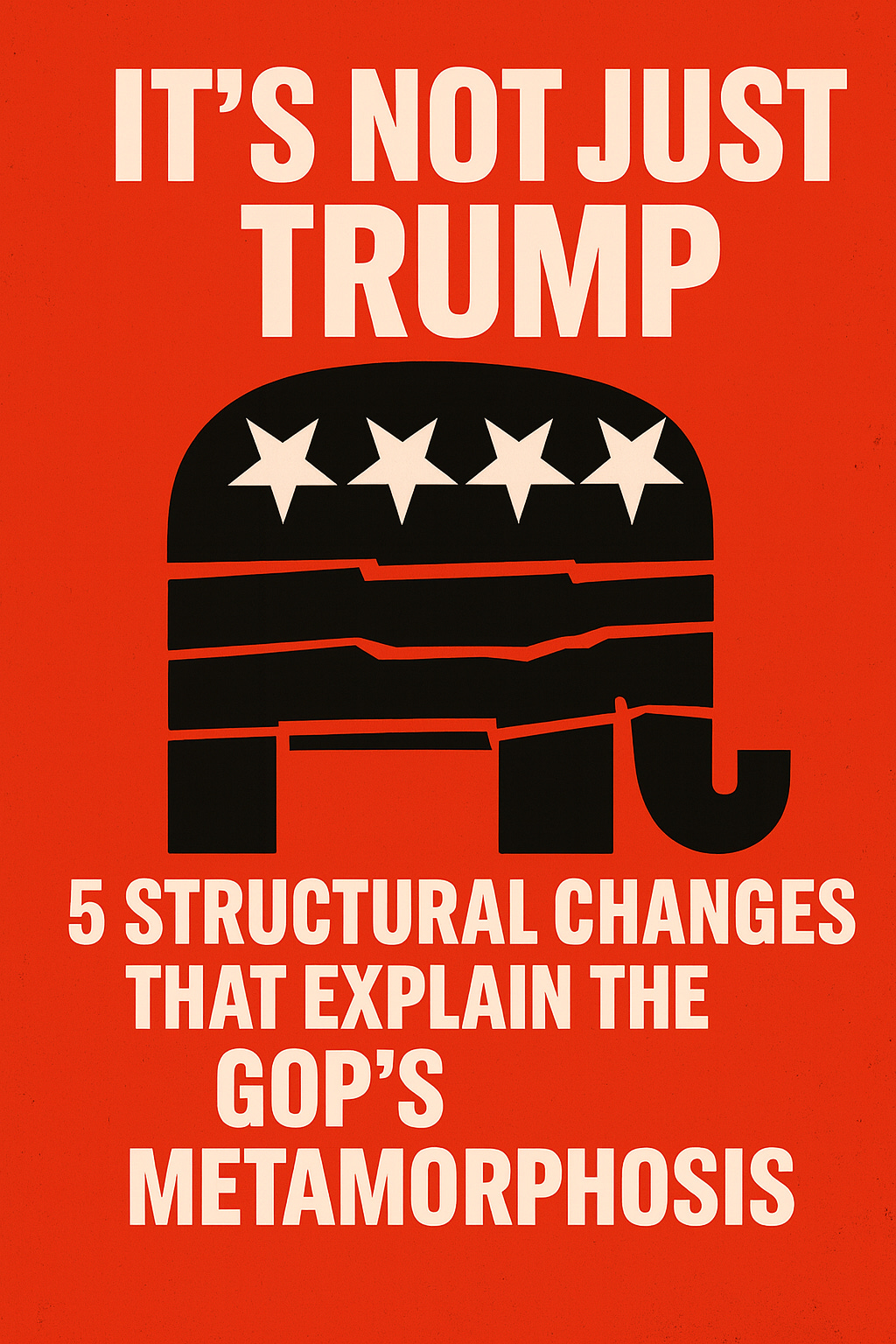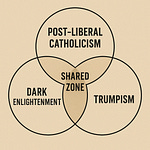Introduction
American political life has always harbored a tension between mainstream governance and its ideological extremes. Yet over the past decade, a profound metamorphosis has unfolded within the Republican Party, largely in plain sight. This transformation goes far beyond the daily headlines and the singular personality of any one leader. It is institutional, strategic, and deeply rooted in a series of calculated shifts.
This post will reveal five of the most surprising and impactful structural changes that explain how the party of Lincoln has become a platform for ideologies once considered unambiguously fringe. By examining the evolution of its rhetoric, the adoption of conspiracy, the reversal of its intellectual institutions, and the creation of an operational plan for authoritarianism, we can understand the quiet revolution that has redefined one of America’s two major political parties.
1. From Coded "Dog Whistles" to Overt "Bullhorns"
The strategic evolution of the Republican Party's rhetoric on race reveals a deliberate and consequential shift from subtext to text. For decades, the party employed the "Southern Strategy," a method perfected in the 1960s and 70s that used coded language—or "dog whistles"—like "law and order" and "states' rights" to appeal to the racial grievances of white voters without using overtly racist terminology.
Republican strategist Lee Atwater famously articulated this evolution in a 1981 interview, explaining the need to move from explicit racism to more abstract, coded appeals:
"You start out in 1954 by saying, 'Nigger, nigger, nigger.' By 1968 you can't say 'nigger'—that hurts you. Backfires. So you say stuff like, forced busing, states' rights and all that stuff."
But the leap to Donald Trump was not direct. The "Gingrich Revolution" of the 1990s provided a crucial intermediate step. House Speaker Newt Gingrich taught a generation of Republicans to frame political opponents not merely as wrong, but as illegitimate enemies who were "sick," "pathetic," and "traitors." This rhetorical escalation created a "ratchet effect," eroding norms of civility and conditioning the party's base to see politics as a moral struggle against a corrupt, un-American foe.
Donald Trump’s primary innovation was to build on this foundation and discard coded racial language entirely, replacing the dog whistle with a bullhorn. He did not invent the underlying sentiment, but he shattered the implicit norms that kept it veiled. This overtness is evident in his foundational public statements:
• Stating that Mexican immigrants are "rapists" who are "bringing crime."
• Describing immigrants as "poisoning the blood of our country."
• Referring to Haiti, El Salvador, and African nations as "shithole countries."
This shift is significant because it eliminated the plausible deniability that had characterized the party's racial politics for half a century. It forced a choice upon every other Republican official: either explicitly condemn the party leader’s language or adopt and defend it. The overwhelming majority chose the latter, normalizing overt white nationalist rhetoric.
2. A Fringe Conspiracy Theory Is Now a Majority Belief
The normalization of extreme rhetoric created fertile ground for the mainstreaming of extreme ideas. One of the most telling indicators of the GOP's transformation is how the "Great Replacement" theory has moved from the extremist fringe to the party's mainstream. This theory posits that a cabal of liberal elites is deliberately replacing white Americans with non-white immigrants in a plot to seize permanent political power.
What was once a core tenet of white supremacist ideology now finds majority support among Republican voters. A 2022 poll found that nearly 7 in 10 Republicans (67%) believe that demographic changes in the U.S. are part of a deliberate plot by liberals to "replace" more conservative white voters.
This belief is no longer just a fringe sentiment; it is reflected and reinforced in official party language, with platform documents and campaign ads referring to a "migrant invasion" that must be stopped. This has created a powerful, self-radicalizing ecosystem. Party leaders amplify the theory, which energizes the base, which in turn pressures more leaders to adopt the same rhetoric to remain electorally viable. In this feedback loop, a dangerous conspiracy has become a core component of the party's worldview.
3. The Conservative "Gatekeepers" Became "Bridge-Builders"
This newly radicalized base, animated by overt nationalist rhetoric and conspiratorial beliefs, began to demand a different kind of intellectual leadership. For much of the mid-20th century, the conservative intellectual movement played a crucial "gatekeeping" role. Figures like William F. Buckley Jr., through his magazine National Review, actively worked to make conservatism respectable by purging extremists, including the conspiratorial John Birch Society, from their ranks.
Today, the most influential institutions in the conservative movement serve the opposite function. Instead of policing the boundaries of conservatism, they act as "bridge-builders" to the far-right, providing intellectual legitimacy and a practical roadmap for ideas that Buckley would have condemned. Two examples stand out:
• The Claremont Institute: This think tank has emerged as a key force providing a philosophical justification for Trumpism. Its most influential contribution was the 2016 "Flight 93 Election" essay, which framed the election as an existential, last-ditch battle for national survival, giving conservatives moral permission to embrace radical measures.
• The Heritage Foundation: Once a mainstream conservative think tank, Heritage now spearheads the development of actionable plans for authoritarian governance, moving from policy suggestions to detailed blueprints for restructuring the federal government.
This reversal marks a collapse of the conservative movement's traditional immune system. It signals a functional merger with the very extremist forces it once sought to keep at bay.
4. There's a 900-Page Playbook to Restructure America
With its intellectual infrastructure captured, the Republican Party's ideological shift is no longer merely rhetorical; it has been operationalized into a concrete, actionable plan. Known as Project 2025, this 900-page document was developed by The Heritage Foundation in partnership with over 100 conservative organizations. It is not a list of suggestions but a detailed authoritarian roadmap for a radical restructuring of the U.S. government.
The project is predicated on the "Unitary Executive Theory," a constitutional interpretation that seeks to concentrate immense power in the presidency, effectively dismantling the system of checks and balances. Its explicit goals represent a fundamental assault on the existing structures of American governance. Its most radical proposals include:
• Eliminating long-standing civil service protections to purge non-partisan professionals and install thousands of ideologically committed loyalists.
• Weaponizing the Department of Justice to investigate and prosecute political opponents.
• Executing mass deportations and ending birthright citizenship.
• Dismantling entire federal agencies, including the Department of Education.
The existence of Project 2025 is impactful because it demonstrates a clear shift from grievance-based rhetoric to a fully articulated, operational plan to implement a nationalist agenda. It is proof of a concerted effort to translate ideology into the machinery of government.
5. Official Condemnations of Racism Are a Tool of Plausible Deniability
This entire radicalization process has unfolded behind a carefully constructed political screen. A comprehensive analysis must acknowledge that the Republican Party has, on occasion, officially condemned racism. Following the violent 2017 "Unite the Right" rally in Charlottesville, for instance, the Republican National Committee (RNC) passed a unanimous resolution stating that "Nazis, the KKK, white supremacists and others are repulsive, evil and have no fruitful place in the United States."
However, these gestures often function as performative disavowals rather than principled rejections of extremism. The central contradiction lies in the party’s simultaneous actions. The same RNC that passed a resolution condemning hate groups later passed another resolution attacking the Southern Poverty Law Center (SPLC), one of the nation’s primary legal and advocacy organizations that tracks and litigates against those same hate groups.
This strategic ambiguity is a deliberate political tool. The official condemnations maintain plausible deniability for moderate voters and corporate donors, providing political cover to deflect criticism. At the same time, this allows the party to continue radicalizing its base and pursuing an exclusivist agenda, allowing the entire institutional capture to proceed without alienating its more traditional supporters.
Conclusion: A Warning, Not Just a Diagnosis
The evidence demonstrates a clear and alarming trajectory. The Republican Party has not simply evolved or shifted further to the right; it has fundamentally mutated in a causal chain of radicalization. An escalating rhetoric of grievance and enmity conditioned a base to embrace conspiracy theories. This radicalized base, in turn, rewarded and co-opted the conservative intellectual movement, which then produced a detailed playbook for authoritarian rule—all while strategic disavowals provided political cover.
A political party animated by white identity, powered by grievance, and armed with authoritarian tools is not a loyal opposition in a democracy. It is a threat to the democratic system itself. When a party views elections as obstacles, immigrants as enemies, and the law as a tool of revenge, it has crossed a Rubicon. As citizens, we must stop asking whether this is “still conservatism,” and start asking the more urgent question:
“Is this still democracy?”










